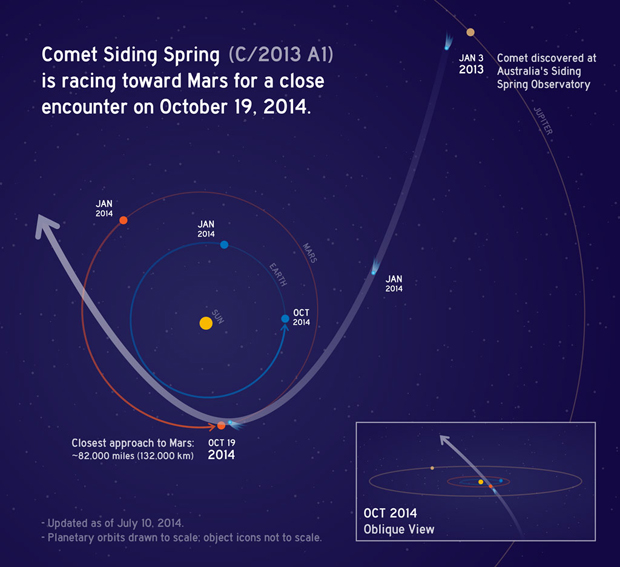Mars orbiters, rovers poised for dramatic comet flyby
An international fleet of five Mars orbiters and two rovers will have ringside seats when a mountain-size comet streaks by on Oct. 19, passing within a scant 87,000 miles of the red planet at a blistering 126,000 mph, NASA scientists said Thursday.
While 87,000 miles might seem like a comfortable margin, it's a near miss in astronomical terms, giving excited scientists a rare opportunity to study a comet from the remote Oort Cloud, a vast swarm of icy debris left over from the birth of the solar system 4.6 billion years ago.
"This comet apparition is so close to Mars that if we put it in our own system, it's coming one third of the distance between the Earth and the moon," said Carey Lisse, an astrophysicist at Johns Hopkins University Applied Physics Laboratory. "It's tail would extend from between the Earth to the moon and its coma would fill about half the distance from the Earth to the moon. It's that kind of size object."
Comet Siding Spring, named after the Australian observatory where it was discovered in January 2013, will make its closest approach to Mars at 2:27 p.m. EDT Oct. 19. The comet should be visible to Earth-bound observers in the southern hemisphere using binoculars or telescopes.
But the Mars spacecraft will have the best seats in the house.
"We're going to observe an event that happens maybe once every million years," Jim Green, director of NASA's planetary science division, told reporters. "And this is where a comet coming from the farthest reaches of the sun's gravity will come to the inner part of our solar system. This comet will fly right in front of the planet Mars. Mars will be blanketed in cometary material."
NASA's Mars Reconnaissance Orbiter will use its high-resolution camera to photograph the comet's nucleus, to map its shape and rotation, its brightness or lack thereof, the composition of its coma -- the tenuous cloud of material around the nucleus that has been boiled away by the sun -- and to look for any changes in the martian atmosphere caused by the comet's passage.
The Mars Odyssey orbiter will study the comet's coma and tail in infrared and visible light while NASA's newly arrived Maven orbiter, designed to study the upper atmosphere of Mars, will make ultraviolet observations and provide even more detail about Siding Spring's possible interaction with the martian atmosphere.
NASA's Curiosity and Opportunity rovers on the surface also will get in on the action, attempting to photograph the comet as it moves across the red planet's sky. The cameras were not designed to image objects as faint as a comet, but engineers are hopeful.
The European Space Agency's Mars Express satellite also will make observations and India's newly arrived Mars Orbiter Mission, or MOM, spacecraft will attempt observations with its main color camera. In a recent Twitter posting, the MOM project said it was "joining the welcome party for comet #SidingSpring. @MarsCuriosity, @MAVEN2Mars, @HiRISE, #MarsOdyssey & #MarsExpress are there too. Excited!"
Earth-based telescopes and other space-based instruments also will be trained on Mars during the encounter, including the Hubble Space Telescope, NASA's Infrared Telescope Facility at Mauna Kea, Hawaii, along with amateur astronomers around the world.
"We're getting ready for a spectacular set of observations," Green said.
Siding Spring, known more formally as C/2013 A1, is approaching Mars from below the plane of the planets. Because it is moving in a retrograde direction, that is, opposed to the movement of the planets in their orbits, its velocity relative to Mars will be a very high 35 miles per second. At that speed, even dust grains post a serious threat to spacecraft in orbit around Mars.
"So anything that comes off the comet that hits Mars or a spacecraft is going to pack a large amount of kinetic energy, a real wallop," Lisse said. "That's one of the things we've been really worried about."
Playing it safe, the NASA satellites were maneuvered recently to make sure they will be on the far side of Mars just after the comet's close approach when the threat of dust impacts from its tail will be highest.
"The hazard is not an impact of the comet nucleus itself, but the trail of debris coming from it," Rich Zurek, chief scientist for the Mars Exploration Program at the Jet Propulsion Laboratory, said in a statement. "The modeling results indicate that the hazard is not as great as first anticipated. Mars will be right at the edge of the debris cloud, so it might encounter some of the particles -- or it might not."
The Mars orbiters and rovers will study the comet throughout the encounter, but it will take hours to days for pictures to make it back to Earth for processing and public release.
"Normally, you would send spacecraft to a comet. In this case, the comet is coming to the spacecraft," said Kelly Fast, a program scientist at NASA headquarters.
"You've got all these spacecraft that are designed to study Mars, but they are repurposing themselves in order to take advantage of this amazing opportunity to study the comet and study what happens when the comet interacts with Mars, when material is deposited in the atmosphere, interaction with the comet's gas coma, is there heating of the atmosphere, an expansion, are there meteors?
"It's a fantastic opportunity."

